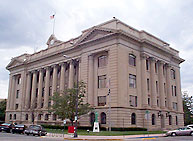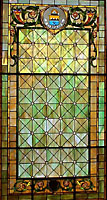Story
Weld County Courthouse
On Independence Day, 1917, ten thousand people attended dedication ceremonies for the Weld County Courthouse in Greeley. Bands stationed in the four story building's arcaded corridors played patriotic music throughout the day and into the evening as citizens toured courtrooms and offices. In an open letter to the public printed by a local newspaper the following weekend, county commissioners expressed the hope that "the future shall justify fully the work which now has been carried to a successful conclusion." Their pride was recently validated by the State Historical Fund, which supported a project to preserve the courthouse's unique pneumatic clock system and stained glass windows.
Weld County's residents had-and still have-good reason to be proud of their monument to justice. Like many early twentieth century public buildings, their courthouse was built in the Classical Revival style. Architect William N. Bowman chose this style because he felt that its design elements reflected the dignity and simplicity of the structure's purpose. On the exterior, three-story columns supporting the building's massive bracketed cornice dominate limestone and granite walls. Inside the main entrance, visitors are greeted by a marble grand staircase leading upward to the main floor. Here, and throughout the building's other main corridors, visitors are treated to a tasteful combination of molded ornamental plaster, carved marble, and bronze light fixtures done in somber, impressive neoclassical motifs. The marble stairways continue, taking visitors and workers to spaces that one may find hard to believe were paid for on the public's dime. For example, the third floor's corridor features a vaulted ceiling that, in the architect's opinion, "lends to the entire floor an atmosphere almost cathedral in character." Paraphrasing philosopher and architecture critic John Ruskin, Bowman compared the building's craftsmanship to "frozen music."
Throughout the past eighty-four years, the building has housed Weld County's courts and their support staff. Colorado's Nineteenth Judicial District also calls the building home. Over time, heavy public use has taken its toll on the structure's components. Most noticeably, the unique pneumatic clock system stopped working. In this system, a "master clock"-which resembles a grandfather clock-uses air pressure to power eight "slave clocks" located throughout the building. A bellows-style pump in the master clock expands and contracts every sixty seconds, forcing air through tiny tubes in the walls that connect to the slave clocks. In the 1970s, the air-driven components were replaced with electrical parts, but these too had failed by 1998.
Damage to the stained glass windows that grace the staircase landing between the third and fourth floors also threatened to diminish the courthouse's grandeur. Due to lead deterioration, some of the panels-which feature the Colorado state seal with acanthus leaves and flowers-were in danger of collapsing. Losing any of the windows would radically compromise Bowman's original design. He once wrote, "A soft light, filtered through beautiful stained glass windows on the west throws a sunset glory over the corridor, making a picture worthy of the brush of any artist."
In 1998, the Nineteenth Judicial District and Weld County teamed up to preserve these two character-defining elements. Led by Shairan Whitman and Mary Bohlender, they requested $55,000 from the State Historic Fund to fix the clock's pneumatic parts and restore the stained glass. Weld County demonstrated its commitment to saving Greeley's signature public building by putting up a $30,000 cash match. Contractors completed both projects in late 1999. Courthouse employees could boast once again that they keep time by one of the few operating pneumatic clocks in the nation. Better yet, it might be said that they, along with the State Historical Fund, saw a window of opportunity and acted just in time.



